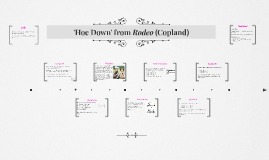Hoedown From Rodeo Program Notes
Carson City Symphony PROGRAM NOTES for October 26, 2008, by Andrew M. Spieker Aaron Copland – 'Hoe-Down' from Rodeo Aaron Copland (1900-1990) was the youngest of five children in a family of Russian immigrants. Despite his tremendous talent, he received no formal musical education until the age of 21, when he was accepted by Nadia Boulanger as her first American student. Copland became one of several American composers of his generation (George Gershwin was another) who successfully blended the popular American musical idiom with the more formal classical style. The ballet Rodeo was commissioned by the Ballet Russe de Monte Carlo in 1942.

The music has a 'southwestern American' flavor, incorporating several folk songs. Moh Pc Openbeta Client R3 582779 Installer. An orchestral suite was extracted form the ballet music. The suite’s finale, the famous, foot stompin’ 'Hoe-Down,' conveys an atmosphere of fun, characterized by brilliant brass and percussion effects.
Wolfgang Amadeus Mozart – Symphony No. 35 in D Major ('Haffner'), K. 385 The 'Haffner' Symphony of Wolfgang Amadeus Mozart (1756-1791) was commissioned by the family of Sigmund Haffner, a friend and benefactor of Mozart. The original version was composed and performed in the summer of 1782. A revised version, the one we know today, was first performed at the Vienna Burgtheater on March 23, 1783. The symphony is in four movements. The first, Allegro con spirito, begins with a powerful statement of the first subject, with all instruments playing in unison.
Rodeo is a ballet composed by American 20th Century composer, Aaron Copland in 1942. There are 4 movements, (sections), i) Buckaroo Holiday, ii) Corral Nocturne iii.
The second subject is similar in melody and rhythm to the first. Contrary to the tradition of the time, no repeat of the exposition is indicated. The development is characterized by a rapid succession of key changes, leading to a recapitulation and ending with a short coda. The second and third movements are courtly, enchanting 'Salzburg party music.'
The slow and graceful melodies of the second movement, Andante, provide a welcome relief to the energy and excitement of the first movement. Instead of a development, a brief chorale-like passage is presented by the woodwinds, clearly punctuated by a syncopated accompaniment by the violins and violas. A recapitulation follows.
This movement can best be characterized as delicate and elaborate, but definitely relaxing. The third movement, Menuetto, provides a bright change of atmosphere from the preceding slow Andante. The movement, in D major, is marked forte (loud). It is punctuated, however, by short sections marked piano (soft), producing a pleasant contrast.
The trio, in the dominant key of A major, is marked piano, providing a clear contrast in dynamics. Zte F660 Software. In true Classical style, the Menuetto is repeated, bringing the movement to its conclusion. The Finale: Presto maintains just as much fire as the first movement. Although it begins at a quiet, brisk pace, the listener is immediately arrested by three beats of silence, followed by the full orchestra playing at a full forte level in bar 9. Such musical surprises appear throughout this movement. Permeated with silences, rapid dynamic shifts, and a bright grace-note passage near the end of the movement, one may expect the unexpected. With its brilliance, fire, and grandeur, it is quite apparent why Mozart chose this music as the final movement of the Haffner Symphony.
George Gershwin – Concerto in F for Piano and Orchestra George Gershwin (1898-1937) was one of the most successful American composers during the 1920s and 1930s. In terms of acceptance during his lifetime, he was unsurpassed: his works, which widely ranged from songs to opera (Porgy and Bess) to orchestral poems (Rhapsody in Blue, An American in Paris) were far more widely accepted than those of more cerebral composers such as Arnold Schoenberg (who, incidentally, was a friend and mentor of Gershwin). The genesis of the Concerto in F dates to a concert in New York of music by contemporary American composers on February 12, 1924, by an orchestra, arranged and conducted by Paul Whiteman. One of the works performed was Gershwin’s Rhapsody in Blue, with the composer as piano soloist. Attending this concert was Walter Damrosch, conductor of the New York Symphony. Damrosch was quite taken by the Rhapsody, and, accordingly, the New York Symphony commissioned the young composer to write a concerto for piano and orchestra.